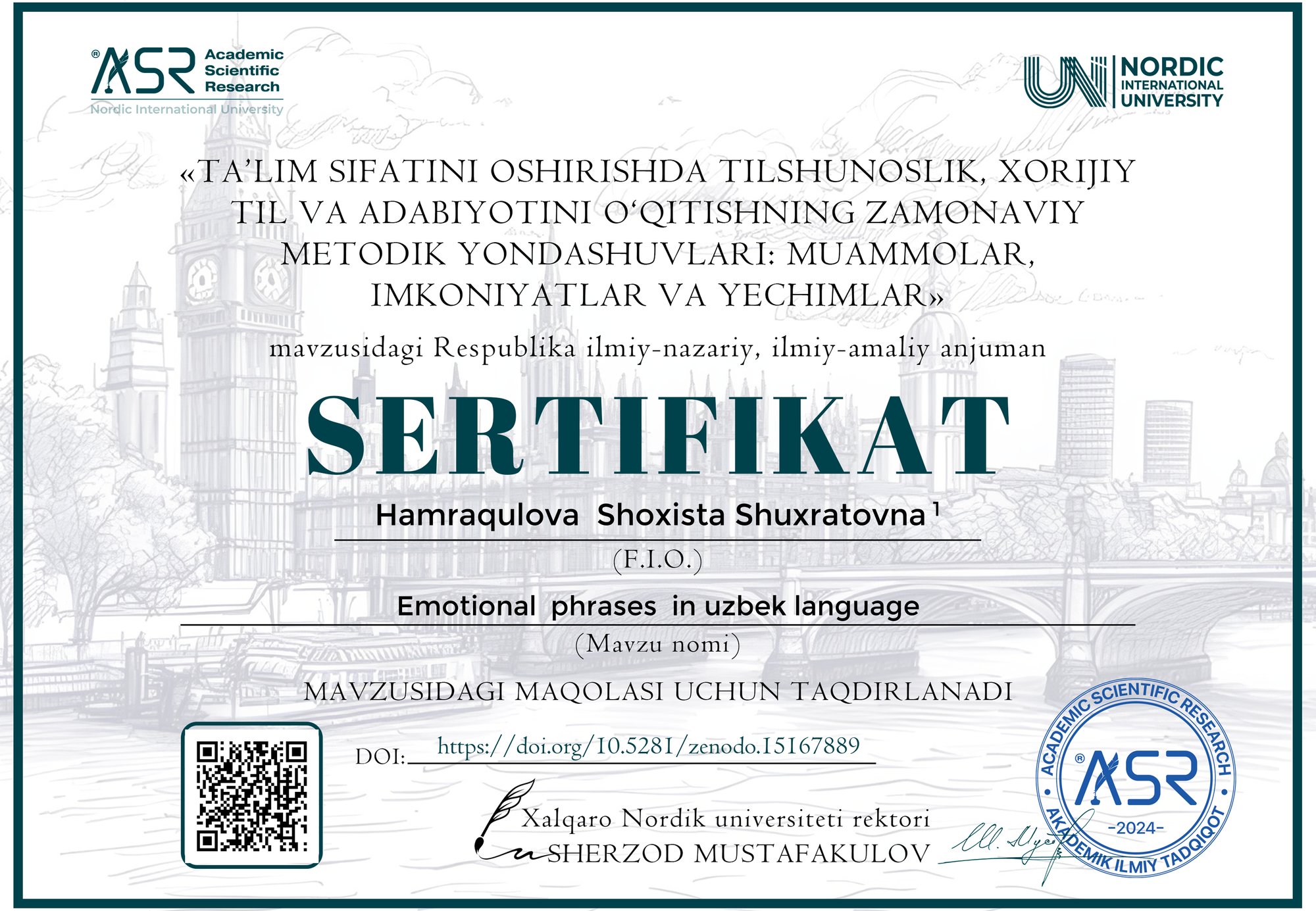Hamraqulova Shoxista Shuxratovna 1

DOI: https://doi.org/10.5281/zenodo.15167889
Google scholar: https://scholar.google.com/scholar?hl=ru&as_sdt=0%2C5&q=%22EMOTIONAL+PHRASES+IN+UZBEK+LANGUAGE%22&btnG=
Zenodo community: https://zenodo.org/records/15167889
Nordic_press journal: https://research.nordicuniversity.org/index.php/nordic/article/view/2240
MAQOLANI YUKLAB OLISH
SERTIFIKATNI YUKLAB OLISH
REVIEW:
The manuscript titled “Emotional Phrases in Uzbek Language” presents a thoughtful and culturally rich exploration of emotional expression within the Uzbek linguistic context. The paper offers valuable insights into the semantic, pragmatic, and cultural dimensions of idioms, interjections, and proverbs as tools for conveying emotional states. It bridges linguistic analysis with cultural interpretation, offering a multifaceted understanding of how emotions are encoded, expressed, and socially shared in Uzbek discourse.
Strengths of the Paper:
Relevance and Originality:
The topic is both relevant and timely, considering the increasing interest in emotion studies, cross-cultural linguistics, and the semantics of expression. The paper contributes to understanding Uzbek as a culturally expressive language, especially in the realm of affective communication.Comprehensive Linguistic Analysis:
The author skillfully discusses metaphorical and phonetic features of emotional phrases, supported by illustrative examples. Notable examples such as “Ko‘ngli tog‘dek bo‘ldi” and “Yuragi yorildi” effectively demonstrate the figurative depth of emotion in Uzbek speech.Cultural Depth:
The section on the cultural and social significance of emotional expressions is particularly strong. The analysis of traditional greetings, hospitality language, and proverbs like “Ko‘ngil ko‘zgudir” reinforces the deep cultural roots of emotional phraseology.Comparative Insight:
The comparison with English and Russian emotional structures adds further depth to the discussion, enabling the reader to appreciate the uniqueness of the Uzbek language while identifying cross-cultural parallels.Structure and Language:
The paper is well-structured with clear headings, logical flow, and an academic tone. The conclusion successfully summarizes the findings and reflects on the broader implications of the study.Points for Improvement:
Literature Integration:
Although the references are relevant and well-selected, a more active engagement with the cited literature within the main body would enhance the theoretical depth of the paper. Specific references could be used to support key arguments more directly.Empirical Support:
The study is primarily descriptive. Including brief examples of corpus data, surveys, or native speaker insights could add an empirical dimension and strengthen the reliability of the claims.Typographical Notes:
A few minor language corrections (punctuation and article usage) could be addressed to further polish the academic style. For example, the title might benefit from a more refined form: “Emotional Phraseology in the Uzbek Language”.Conclusion and Recommendation:
Overall, this paper demonstrates a strong understanding of the linguistic and cultural dynamics of emotion in the Uzbek language. It is well-organized, engaging, and contributes meaningfully to the field of cultural linguistics and pragmatics.



